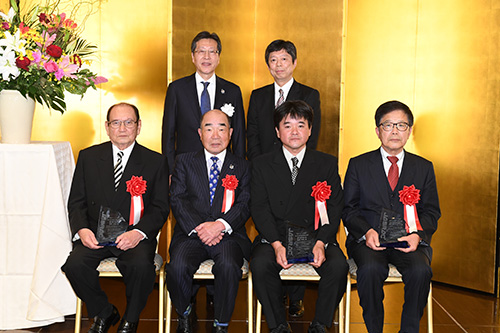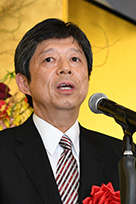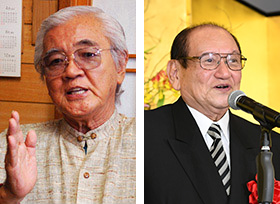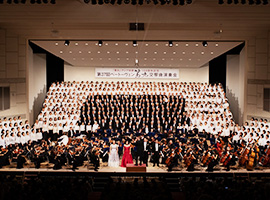- > Top Page
- > About JASRAC
- > JASRAC Music Culture Award
- > “The Fifth JASRAC Music Culture Award”
“The Fifth JASRAC Music Culture Award”
JASRAC Music Culture Award was established in November 2014 to shed light on individuals, organizations and works in various fields that contribute to the development of music culture, through important activities that may otherwise not be heralded or lead to impressive statistics in sales and works usage, to provide encouragement for future endeavor.
The fifth award was presented to the following individuals and organization by Michio Asaishi, President of JASRAC, in the award ceremony held in Tokyo on November 16, 2018. The recepients were presented with plaques and additional prizes.

Tatsuya Tonoshita

Reason behind his receiving the award
Using historical evidence from over 150 years from the singing practices of education in the Meiji era to contemporary J-pop, his books and editorial works have illuminated modern Japanese music history that was previously uncharted, especially the role and nature of music under the war regime. Tatsuya Tonoshita objectively reviewed how popular musical culture evolved and its reasons, as well as the reasons for its transformation.
Comments
It gives great pleasure but also brings great responsibility to be awarded the JASRAC Music Culture Award along with people who are working on music taking root in history and various regions. I would like to further explore the role music has played and how they have been sung in Japan, passing on the story for the next generation to pursue.
Profile of the awardee
Tatsuya Tonoshita was born in Tokyo in 1963. Majoring in early modern and modern music history, he has written books including '“Kokuminka” wo Showa Shita Jidai, 'Ongaku wo Doin Seyo', and 'Senjika Ongakukai no Saihen Togo'. Editorial works include 'Nihon no Suisogaku Shi'. Co-editorial works include 'Sengo no Ongaku Bunka', 'Nihon no Gassho Shi', 'Soryokusen to Ongaku Bunka', 'Tatakau Ongakukai', and editing of reprints and bibliography for 'Ongaku Bunka Shinbun'. He contributes concert reviews and discussions to 'Hanna' and 'Ongaku Gendai' magazines and is also actively engaged in the planning and production of concerts.
Tsuneo Fukuhara and Yoshikatsu Bise

Reason behind their receiving the award
Based in Okinawa City, Mr Fukuhara and Mr Bise not only created masterpieces of Shima-uta (folk songs originating in the Amami Islands) and Okinawa Kayou (popular Okinawan music) but also fostered succeeding musicians. They have been community-based record shop owners and music producers, introducing music in a wide range of genres rooted in Okinawa culture to the rest of Japan. They built the foundation for Okinawa City to prosper as a 'music city'.
Comments
Mr Fukuhara: I regard this as a reward for my passion for Ryukyu Island music over a long period of time. It feels like I have received my blessings and fortunes all at once. We have assisted many artists, and I would like to express my deepest gratitude to all the people involved.
Mr Bise: Without Mr. Fukuhara, I don't think I would have been involved in music-related jobs. I was just producing records and events just within “music city” Koza (located in Okinawa City), so I am amazed by this award. Thank you very much.
Profile of the awardee
Tsuneo Fukuhara was born in 1932 and is dubbed as a hit-maker in post-war Okinawa Minyou (Okinawan folk songs). From his classic 'Bashofu' to the grand Ryukyu traditional suite 'Shoen', he is renowned for his passionate creative activities. Meanwhile, as a music producer for Marufuku Record, a record company with a 91-year history, Mr. Fukuhara has introduced many Shima-uta and Okinawa Kayou works, influencing musicians both in and out of Okinawa prefecture.
Born in 1939, Yoshikatsu Bise is a lyricist, also running Campus Records (record production and sales) in Okinawa City. Producing many Shima-uta and Okinawa Kayou works, he has introduced music in a wide range of genres rooted in Okinawan culture. Mr. Bise is also the director of Ongakumura, a music museum and resource center located in the city.
Certified NPO Organization Sing DAIKU in NARUTO

Reason behind its receiving the award
In 1918, despite an ongoing state of war, Beethoven's Symphony No.9 was performed for the first time in Asia. It took place in Naruto City, and the Sing DAIKU in NARUTO (Naruto Society for Singing Symphony No.9) has passed down the passion for singing Symphony No.9 with fans of the piece all over Japan. They have held numerous overseas performances at locations associated with the music and have interacted with families of German POWs who performed at the first concert. Transcending time and borders, they are bringing back to life the moving and miraculous event from 100 years ago, now a part of history.
Comments (Vice chairman Toshiaki Kamei)
Thank you for placing the spotlight on our activities. We have deepened international exchange through Symphony No.9. Today, beset with intolerant societies and constant tension between races and creeds, we are determined to continue our activities in hope that everyone can embrace diversity through music.
Profile of the awardee
Sing DAIKU in NARUTO was first formed as a choir in 1981 and became a legal entity in 2013 with Michiko Otsuka as the Chairperson. They have performed Symphony No.9 in June every year in Naruto City with fans of the piece from all over Japan. It all began with WWI, when German POWs at a camp located in the city were permitted cultural activities in consideration of their human rights and all movements of Symphony No.9 were performed on June 1, 1918 for the first time in Asia. In June 2018, a concert was held marking the 100th anniversary of the first performance, together with a memorial project gathering a total of 1,200 choir members from Japan, Germany, China and the United States performing the music enthusiastically over two days. Families of former German POWs were also invited to this event. The organization has also participated in numerous joint concerts with local choirs at worldwide locations associated with Symphony No.9.
